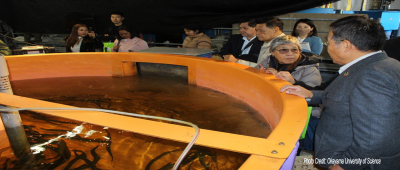The Municipality of Dalaguete in the southern part of Cebu province is poised to employ new technology in fisheries and aquaculture industries, following the town officials’ visit to Japan led by Mayor Ronald Allan Cesante. In an interview with Cesante, he said there is a need to boost fish production, both from sea and freshwater sources, to meet the growing demand, particularly within the Cebu province. Cesante cited the 2020 data, revealing that Cebu province’s market demand for fish products stands at 200,000 metric tons annually. Regrettably, Cebu currently falls significantly short, producing only 38,000 to 40,000 metric tons per year. With this new Japanese technology, seawater fish can be cultured in a freshwater environment through several processes known in Japan as “third water” technology.
Cesante, together with Dr. Roldan Saragena, the province’s head of the Department of Agriculture (DA) visited Japan last November 13-14, 2023, along with private sector representatives, to personally witness the new technology on aquaculture. Hiroyuki Hirano, the President of the Okayama University of Science, and Professors Toshimasa Yamamoto and Akihiro Orita, faculty members of Okayama University of Science Department of Engineering, introduced to the Cebu delegation the successful implementation of land-based aquaculture using freshwater in fish tanks situated in the mountains and other inland areas of Japan, Cambodia, and Mongolia.
Aside from Mayor Cesante and Dr. Saragena, the delegates were composed of Engr. Expedizitas S. Lenares, Engr. Jireh G. Burda, Mrs. Joanna J. Cesante, Mr. Jose Manuel A. Canton, and sisters Teresa and Myriam Canton. The delegates were informed that Professor Yamamoto’s groundbreaking aquaculture technology has the potential for successful replication in third-world countries, with a particular focus on its applicability in the Philippines.
Considering the pressing food security concerns in the Philippines, Okayama University of Science has affirmed its commitment to providing technical assistance and technological support through its experts, notably Professor Yamamoto. “I was surprised to see a land-based aquaculture facility in the mountains. We are from a similar area [like in Mantalongon, Dalaguete], so this will be a good reference for us,” said Cesante. He further highlighted that malnutrition is an escalating issue in his town, underscoring a substantial deficiency in protein nutrients that can be derived from both fish and meat sources.
Given the unpredictable fish production in seawater attributed to climate change, Cesante stressed the crucial need to establish a robust aquaculture facility within the town. This facility is anticipated to not only yield freshwater fish but also a diverse array of wild seawater fish, providing a more stable and sustainable source. The Mayor hopes that what the delegates learned during the two-day immersion can be applied to create land-based aquaculture facilities not just in Dalaguete but across the Philippines. Mantalongon, the second-largest barangay in Dalagute, is known as the vegetable basket of Cebu, Cesante’s focus extends to the development of a four-hectare land donated by Jose Manuel Canton. This area is earmarked to become an eco-tourism, serving as the site for innovative aquaculture initiatives.
At the same time, the land will also be used to produce high-value crops like zucchini, leaks, heart, and cherry tomatoes, among others. In line with the program set forth by the newly appointed DA secretary Francisco Tiu Laurel, Cesante emphasized that one of his top priorities is the advancement of the town’s aquaculture and mariculture industries. He views these developments as the ultimate solutions to address both food security and poverty issues.
Source: The Freeman Cebu Business (https://www.philstar.com/the-freeman/cebu-business/2023/11/24/2313850/dalaguete-use-japanese-tech-boost-fish-production)

